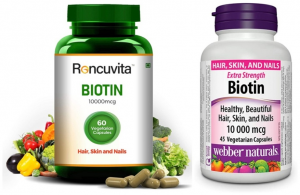-
Make a Call : +86 551 63500087
-
Get A Estimate : sales@gnfchem.com
What Are You Looking For?
What Are You Looking For?
Make a Call : +86 551 63500087
Get A Estimate : sales@gnfchem.com

Biotin, an important nutrient for the human body
Jul 24, 2024Vitamins are essential micronutrients that cannot be produced by the organism itself, but have to be obtained exogenously, for example through the diet. Vitamins are not able to produce energy in the same way as sugars, proteins and fats, however, they do regulate the metabolism of the organism. It is well known that vitamin deficiency can lead to many health problems, for example, vitamin A deficiency can lead to night blindness and dry eyes, vitamin C deficiency can lead to scurvy, and vitamin D deficiency can lead to rickets, etc. Therefore, it is important to consume vitamins in an appropriate amount to maintain the health of the body. In recent years, there has been a proliferation of vitamin-based nutritional supplement, including one called "biotin", which claims to be crucial for hair and nail growth, skin repair, and nutrient metabolism.
History of biotin
Biotin, also known as Vitamin H or Coenzyme R, is a member of the water-soluble B vitamins, and its many names are inextricably linked to its 40-year history of research. 1916, biochemist W. G. Bateman discovered that rats that consumed large quantities of raw egg whites exhibited hair loss and skin damage. 1936, German chemists F. Kögl and J. Kögl discovered that the skin of rats was damaged by raw egg whites. In 1936, German chemists F. Kögl and B. Tönnis isolated a crystalline substance from hard-boiled egg yolks that promoted the growth of yeast, and named it "biotin" (Biotin). Soon after, the American scientist P. György discovered a substance that could prevent dermatitis and hair loss (induced by feeding raw egg whites to rats) in 1937, and therefore named the substance "Biotin" (Biotin) after the initials of "Haut" (skin) and "Haar" (hair) in the German language. Therefore, using the initials of the German words for skin and hair, "Haut" and "Haar", the substance was named "Vitamin H". It should be noted that the American biochemist F. E. Allison et al. also isolated a substance from egg yolk in 1933 that is essential for the growth of Rhizobium leguminosarum, and proposed that this substance is a cofactor for respiration, and named it "coenzyme R". Coenzyme R". It was not until 1940 that P. György and V. Vigneaud, among others, experimentally proved that the so-called biotin, cofactor R, and vitamin H were all the same substance. At the same time, since biotin was the seventh B vitamin discovered by chemists, it was named vitamin B7
Physiological functions of biotin
Biotin is a cofactor in the enzyme system associated with the carboxylation and decarboxylation reactions in the body's metabolism, and is able to participate in carboxylation reactions, glycogen isomerization, and protein synthesis. Thus, biotin is essential for life, growth and maintenance of epithelial tissues, and reproduction. In addition, biotin plays an important role in the metabolism of carbohydrates, fatty acids, proteins and nucleic acids in the body. In most cases, people are more concerned about their nutritional and health functions, and it is now widely recognized that biotin has a positive effect on the maintenance of the normal function of skin, nails, and hair, and that a deficiency of biotin leads to thinning of hair, loss of luster, graying of hair and hair loss, and dermatitis and eczema, among other skin symptoms. Nevertheless, because biotin is so widely available (found in a variety of foods including egg yolks, nuts, legumes, fish and fruits), it can be consumed in the daily diet without additional supplementation. However, studies have also shown that diabetes, pregnancy and malnutrition can lead to biotin deficiencies, which require appropriate exogenous supplementation.
Biotin biosynthesis
Biotin is synthesized by plants and bacteria in nature to fulfill normal physiological functions, and both plants and bacteria use the same starting material and reaction pathway for biotin synthesis. That is, L-alanine 1 and heptanedioic acid 2 are used as starting materials, and firstly, 7-carbonyl-8-aminononanoic acid 3 is formed through the condensation process, and then 7,8-diaminononanoic acid 4 is formed through the transamination process of the carbonyl group. next, the biotin synthesizing enzyme (desulfurized biotin synthase) is used to synthesize biotin. Desulfobiotin 5 is obtained by further condensation under the action of dethiobiotin synthase (DBS) and finally, the final product is obtained under the action of biotin synthase.
Chemical Synthesis of Biotin
As mentioned before, biotin plays an important role in the biochemical synthesis of fatty acids, glycolysis and other biochemical reactions, and a lack of biotin in the human body can cause a variety of nutritional diseases. In addition, the lack of biotin in poultry will also lead to growth retardation, stunting and even death, especially with the continuous development of poultry and animal husbandry, the demand for biotin as a feed additive has increased dramatically. Therefore, the chemical synthesis of biotin is necessary and urgent.
So far, the total synthesis strategies of biotin reported in the literature are basically divided into two kinds, i.e., enantioselective synthesis and stereospecific synthesis. In the former, fumaric acid is used as the raw material to construct the three chiral carbon centers in the molecule through asymmetric synthesis or other chiral techniques and undergo a multi-step reaction to finally obtain the target product with sufficient optical purity. Another strategy is to use chiral compounds such as L-cysteine as starting materials, and with the help of the inherent chiral carbon atoms in the raw materials, to construct the biotin molecule through structural transformation, and then to construct the biotin molecule.
In 1946, Roche researchers Goldberg and Sternbach reported the first asymmetric total synthesis of a biotin. The team used fumaric acid 1 as the starting material, which first underwent bisbromination, nucleophilic attack of the halogen atoms by benzylamine, and subsequent further reaction with phosgene to obtain intermediate 2, which, through the process of intramolecular dehydration of 2, formed the acid anhydride compound 3.3 In the presence of acetic anhydride, partial reduction of the anhydride using zinc metal produces the racemate compound 4 and further reduction of 4 yields compound 5. Thereafter, using Grignard's reagent, the side chain is introduced into the cyclic backbone and through subsequent elimination reactions, the key building block 6 is formed. through a process of stereoselective hydrogenation of the double bond in 6, the block 7 is obtained and through a subsequent acidic Next, a splitting and stepwise crystallization process involving chiral camphorsulfonates leads to the key chiral block 9, and finally, a nucleophilic ring opening of 9 and a subsequent deprotection step under acidic conditions using sodium salt of diethyl malonate leads to the final chiral pure biotin [4]. It should be noted that the pioneering research of Goldberg and Sternbach's team laid a solid foundation for the design of the industrialized synthetic route of (+)-biotin, and therefore, this route is referred to as the Hoffmann-La Roche (HLR) route in the literature.In 2001, Fen-er Chen's group improved the HLR route and opened up a more complete industrialized synthetic route.
Applications of Biotin
In addition to its use as a nutritional additive, biotin has a wide range of applications in biochemical research. For example, the ovalbumin in eggs binds strongly and almost irreversibly to biotin, which makes it possible to bind biotin to target molecules and use ovalbumin for testing. In addition, biotin exhibits low toxicity in a wide range of physiological and pathological processes, and thus can be designed as a target-selective drug carrier for effective delivery of anticancer drugs to tumor cells. Currently, biotin-containing small molecules have been developed into a class of biofunctional molecules with good application value, and these compounds have the advantages of simple synthesis, easy functionalization and high specificity.
Biotin is a very important nutrient in the process of biological growth and development, which can participate in a variety of metabolic activities of the organism, and is widely used in the fields of food, medicine, feed, fermentation, etc., and at the same time, it has an important impact on the industrial and agricultural production as well as the daily life of the people. Therefore, it has been favored by chemists and biologists in recent years. In addition, scientists have begun to discover that biotin molecules also have other completely new functions. Thus, biotin will make an even more important contribution to future research.
GNFCHEM is professional Food Additives manufacturer, please follows us and get more products catalogue and price!

Hi! Click one of our members below to chat on